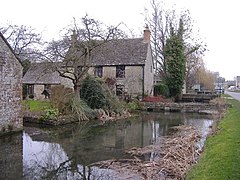Ashton Keynes
| Ashton Keynes | |
|---|---|
 The Thames entering the village boundaries |
|
 Buildings and the Thames along the main road through the village (High Road) |
|
| Ashton Keynes shown within Wiltshire | |
| Population | 1,400 (in 2011) |
| OS grid reference | SU046940 |
| Unitary authority | |
| Ceremonial county | |
| Region | |
| Country | England |
| Sovereign state | United Kingdom |
| Post town | SWINDON |
| Postcode district | SN6 |
| Dialling code | 01285 |
| Police | Wiltshire |
| Fire | Dorset and Wiltshire |
| Ambulance | South Western |
| EU Parliament | South West England |
| UK Parliament | |
| Website | Parish Council |
Ashton Keynes is a village and civil parish in north Wiltshire, England which borders with Gloucestershire. The village is about 5 miles (8 km) south of Cirencester and 3.5 miles (5.6 km) west of Cricklade. At the 2011 census the population of the parish was 1,400. The village lies within the Cotswold Water Park and is the only settlement substantially on both sides of the River Thames, which has many channels here, centred 6.5 miles (10 km) from its source at Thames Head.
The parish includes the hamlet of North End.
The village was known as Aesctun in 800 AD, appeared in the Domesday Book within Cricklade hundred as Essitone in 1086. Ten variants of the name are recorded over the next 800 years.
A large Romano-British settlement was on the edge of the present-day village; it was excavated in the late 1980s in advance of extensive gravel extraction. Ashton Keynes Castle (or Hall's Close) was a 12th-century ringwork, just north of the village.
The manor was held by the de Cahaignes or Keynes family, and this was incorporated into the village name.
Ashton House was built in the 18th century and is Grade II listed.
In 1851 in the 35 homes in Gosditch were living a tailor, saddler, tallow chandler, stonemason, many glove makers and a cobbler. The Horse and Jockey (now closed) was a "scrumpy house", selling cider made from the apples from the orchards in the village. This was the social centre of the community where dominoes were laid and gossip exchanged, and the hard times debated.
The Church of England parish church of the Holy Cross is Grade I listed. The building was begun in the 12th century and was restored in 1876-7 by William Butterfield.
...
Wikipedia

